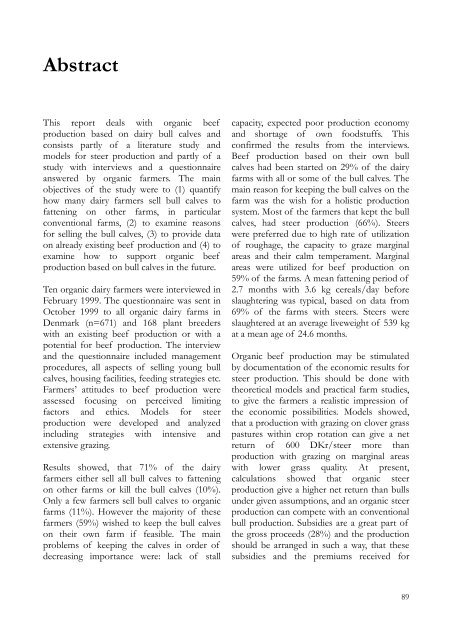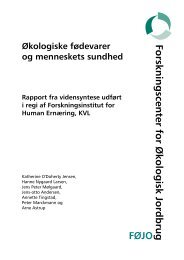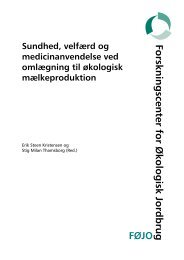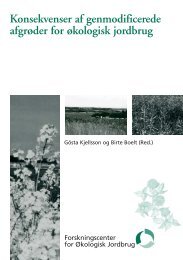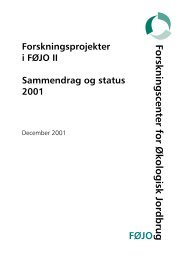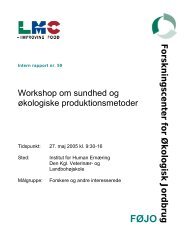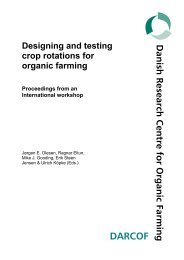Økologisk oksekødsproduktion baseret på tyrekalve fra ...
Økologisk oksekødsproduktion baseret på tyrekalve fra ...
Økologisk oksekødsproduktion baseret på tyrekalve fra ...
You also want an ePaper? Increase the reach of your titles
YUMPU automatically turns print PDFs into web optimized ePapers that Google loves.
Abstract<br />
This report deals with organic beef<br />
production based on dairy bull calves and<br />
consists partly of a literature study and<br />
models for steer production and partly of a<br />
study with interviews and a questionnaire<br />
answered by organic farmers. The main<br />
objectives of the study were to (1) quantify<br />
how many dairy farmers sell bull calves to<br />
fattening on other farms, in particular<br />
conventional farms, (2) to examine reasons<br />
for selling the bull calves, (3) to provide data<br />
on already existing beef production and (4) to<br />
examine how to support organic beef<br />
production based on bull calves in the future.<br />
Ten organic dairy farmers were interviewed in<br />
February 1999. The questionnaire was sent in<br />
October 1999 to all organic dairy farms in<br />
Denmark (n=671) and 168 plant breeders<br />
with an existing beef production or with a<br />
potential for beef production. The interview<br />
and the questionnaire included management<br />
procedures, all aspects of selling young bull<br />
calves, housing facilities, feeding strategies etc.<br />
Farmers’ attitudes to beef production were<br />
assessed focusing on perceived limiting<br />
factors and ethics. Models for steer<br />
production were developed and analyzed<br />
including strategies with intensive and<br />
extensive grazing.<br />
Results showed, that 71% of the dairy<br />
farmers either sell all bull calves to fattening<br />
on other farms or kill the bull calves (10%).<br />
Only a few farmers sell bull calves to organic<br />
farms (11%). However the majority of these<br />
farmers (59%) wished to keep the bull calves<br />
on their own farm if feasible. The main<br />
problems of keeping the calves in order of<br />
decreasing importance were: lack of stall<br />
capacity, expected poor production economy<br />
and shortage of own foodstuffs. This<br />
confirmed the results from the interviews.<br />
Beef production based on their own bull<br />
calves had been started on 29% of the dairy<br />
farms with all or some of the bull calves. The<br />
main reason for keeping the bull calves on the<br />
farm was the wish for a holistic production<br />
system. Most of the farmers that kept the bull<br />
calves, had steer production (66%). Steers<br />
were preferred due to high rate of utilization<br />
of roughage, the capacity to graze marginal<br />
areas and their calm temperament. Marginal<br />
areas were utilized for beef production on<br />
59% of the farms. A mean fattening period of<br />
2.7 months with 3.6 kg cereals/day before<br />
slaughtering was typical, based on data from<br />
69% of the farms with steers. Steers were<br />
slaughtered at an average liveweight of 539 kg<br />
at a mean age of 24.6 months.<br />
Organic beef production may be stimulated<br />
by documentation of the economic results for<br />
steer production. This should be done with<br />
theoretical models and practical farm studies,<br />
to give the farmers a realistic impression of<br />
the economic possibilities. Models showed,<br />
that a production with grazing on clover grass<br />
pastures within crop rotation can give a net<br />
return of 600 DKr/steer more than<br />
production with grazing on marginal areas<br />
with lower grass quality. At present,<br />
calculations showed that organic steer<br />
production give a higher net return than bulls<br />
under given assumptions, and an organic steer<br />
production can compete with an conventional<br />
bull production. Subsidies are a great part of<br />
the gross proceeds (28%) and the production<br />
should be arranged in such a way, that these<br />
subsidies and the premiums received for<br />
89


